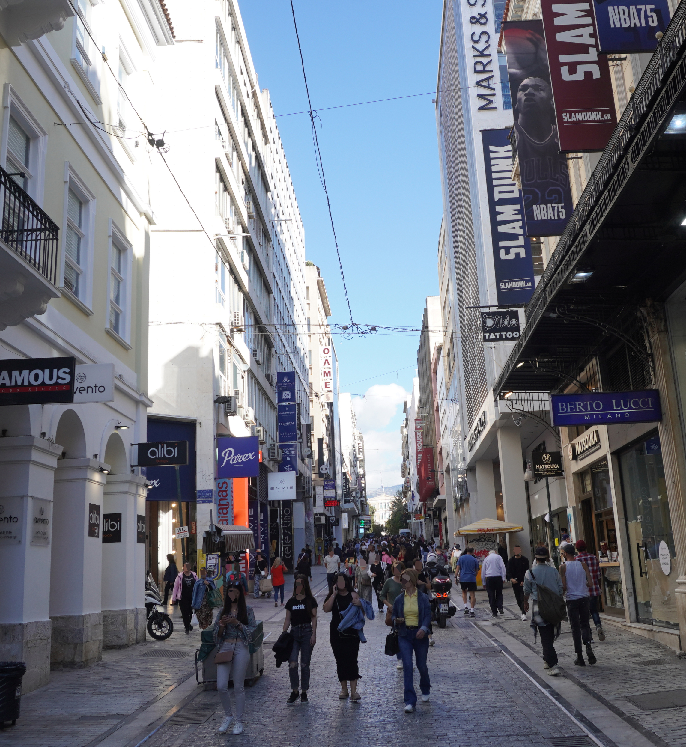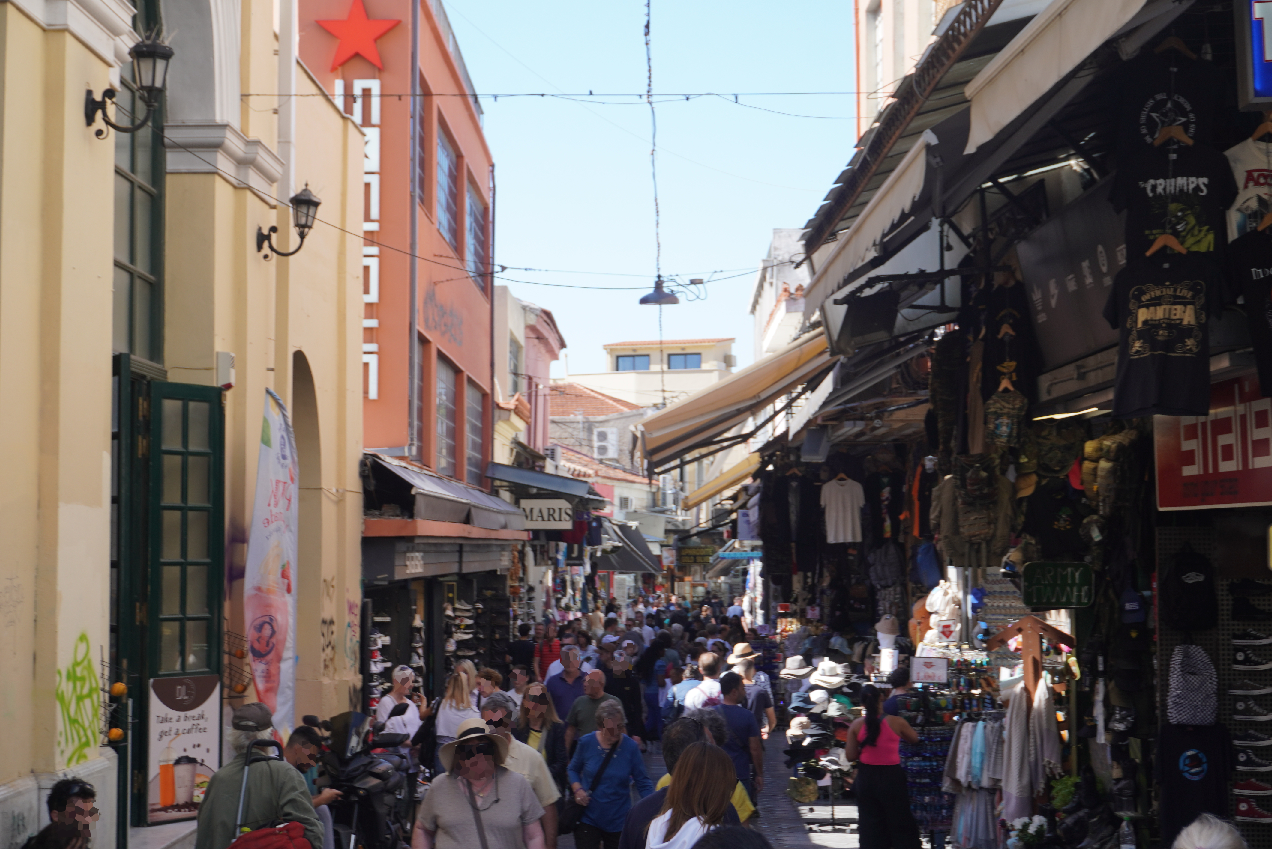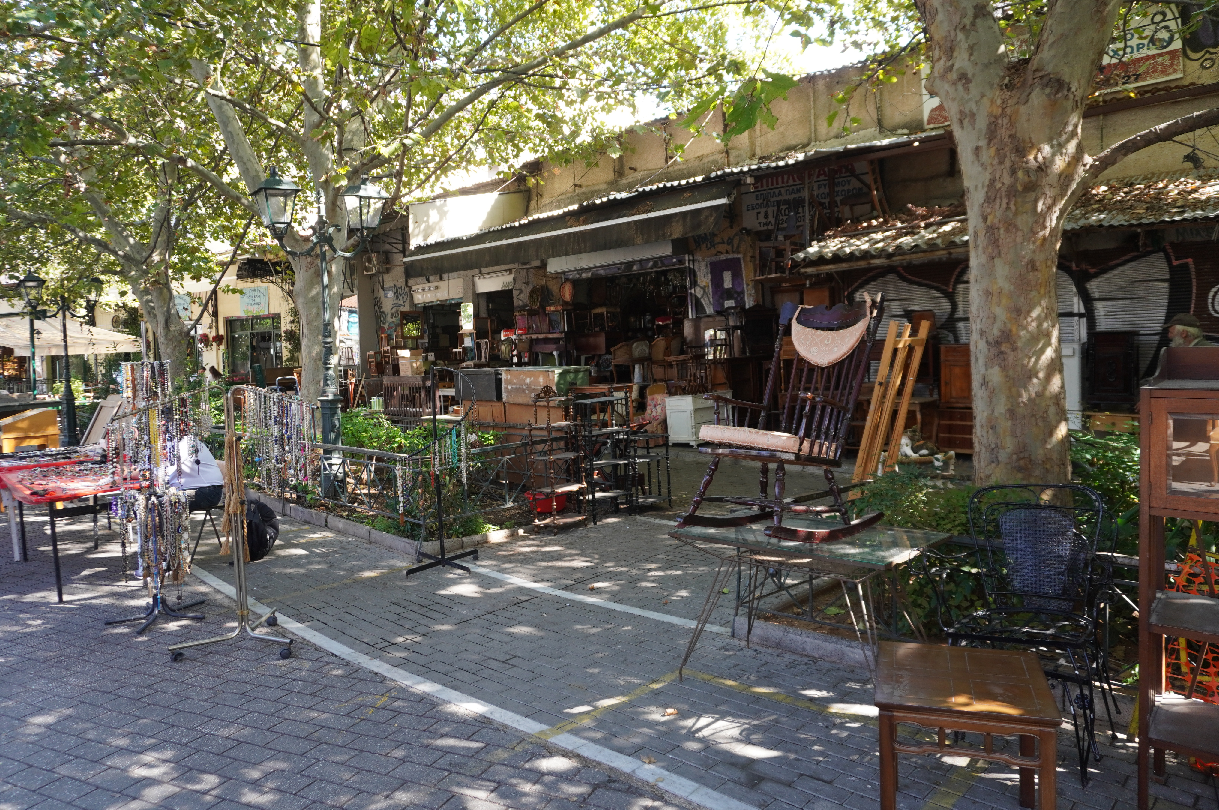Useful
Information
Useful information
Great Archaeological Walk of Athens
Syntagma – National Garden – Zappeio – Panathenaic Stadium – Temple of Olympian Zeus – Acropolis – Thiseio – Monastiraki – Ermou – Syntagma
Perhaps the most famous walking route in Athens, combining the city’s archaeological wealth with iconic churches, shopping, and gastronomy. The route passes through the city center, the National Garden, Zappeio and some of the most famous archaeological sites. After a circular route of a particular interest, it returns to the starting point. Due to the plethora of monuments, museums, and other points of interest along the route, one day is not enough for a full visit. The estimated duration of the route does not include any stops or visits. The main route passes within squares, gardens, parks, pedestrian zones, etc., which are also suitable for people with disabilities. However, that is not the case for visits outside the main route.
The route includes the following landmarks. The landmarks’ sequence indicates the direction of the route.
Note: The travelers are solely responsible for their own personal direction and safety. The present report, the relevant tracks (gpx) and the rest of the informational material are just supplementary. The proper equipment is necessary, depending on the weather conditions and the characteristics of the route.
Main Landmarks:
- Syntagma Square
- Tomb of the Unknown Soldier
- Hellenic Parliament
- National Garden
- Zappeio
- Panathenaic Stadium – Finish Line of the Classical Marathon
- Columns of Olympian Zeus
- Arch of Hadrian
- Acropolis Metro Station – Archaeological Exhibition
- Acropolis Museum
- Theatre of Dionysus
- Odeon of Herodes Atticus
- Filopappou Hill (Hill of the Muses)
- Areopagus Hill
- Acropolis
- Propylaia
- Caryatids
- Temple of Athena Nike
- Hill of the Nymphs
- Thissio Open-Air Cinema
- Thiseio
- Church of Agios Philippos Vlassarous
- Ancient Agora of Athens
- Temple of Hephaestus
- Stoa of Attalos
- Temple of Ares
- Stoa of Zeus
- Bouleuterion at the Ancient Agora
- Monastiraki
- Monastiraki Metro Station – Archaeological Site
- Church of the Pantanassa
- Tzisdarakis Mosque
- Hadrian’s Library
- Roman Agora
- Tower of the Winds
- Church of Panagia Kapnikarea
- Ermou Street
- Syntagma Square
Syntagma Square is the central square of Athens and one of the largest in the country. Its name originates from the Constitution (Syntagma in Greek), which King Otto was forced to grant due to the 3 September 1843 revolution. It is surrounded by significant buildings such as the Hellenic Parliament (formerly the Royal Palace), the historic Grand Bretagne Hotel, and the Ministries of Finance and Foreign Affairs. Access from the square to Amalias Avenue is via a central marble staircase. The steps of Syntagma Square, along with the 19th-century marble fountain in its center, serve as a meeting point for Athenians as well as visitors. The square features numerous cafes where you can relax and enjoy the sunshine.
Due to its proximity to the Hellenic Parliament, it is the starting and ending point for protests or marches. It is located near many attractions in central Athens and within walking distance from the neighborhoods of Plaka, Monastiraki, Kolonaki, and Psiri. The changing of the guard in front of the Tomb of the Unknown Soldier, situated in a designated area in front of the Parliament building on Amalias Avenue, holds a particular interest. Every hour, two new guards replace with precise and synchronized movements the previous two guards, known as Evzones. On national holidays and Sundays, the ceremonial changing of the guard is performed by 120 Evzones at 11 a.m.
The National Garden (Ethnikos Kipos in Greek) is located just a few meters away from Syntagma Metro Station, right next to the Hellenic Parliament and it is accessible through seven entrances. We enter through its main entrance on Amalias Avenue. Before being renamed as the National Garden in 1924, the garden was known as the Royal Garden or the Garden of Amalia, named after the first Queen of Greece, who founded it. Queen Amalia herself planted the distinctive Washingtonia fan palms, which are approximately 25 meters high, encountered upon entering the garden through the gate on Vasilissis Amalias Avenue. The garden is home to 7,000 trees, 40,000 shrubs, and other plants, belonging to 519 species and varieties. 102 of these species, namely Judas trees, oleanders, and carob trees are Greek, while others originate from various countries around the world. During your walk, you will see six lakes in total and you will encounter playful ducks that you can feed. Near the entrance, on Vasilissis Sofias Avenue, you will see the Roman mosaic floor from the atrium of a Roman villa. A notable attraction is the famous sundial located at the main entrance. You can visit the traditional cafe operating in the garden from Herodou Attikou Street.
Moving south from the National Garden and the Parliament, you will come across Zappeion Hall, or simply Zappeion, one of the most important neoclassical buildings in Athens. In 1869, the Greek government designated 80,000 square meters of public land for the building, in the area between the Palace’s Gardens and the ancient Temple of Olympian Zeus. The Zappeion was the first building in the world that was ever constructed exclusively for the Olympic Games of 1896. Its construction was financed by the national benefactor Evangelos Zappas, and it was completed in 1888 by the Danish architect Theophil Hansen. The statues that adorn its enclosure are remarkable. At the garden of Zappeion Hall you will find distinctive sculptures, including the busts of politicians, kings, and historical figures, satyrs, and small, shy Cupids. One of the most impressive is undoubtedly the one showing Lord Byron being crowned by Greece symbolizing the gratitude for his contribution to the Greeks’ struggle against the Ottomans. It was created by Henri Michel Antoine Chapu, Jean Alexandre Joseph Falquiere, and Lazaros Sochos.
The Zappeion is intertwined with the history of modern Greece. It is where the historic treaty for Greece’s accession to the European Union (then EEC) was signed on January 1, 1981, by Konstantinos Karamanlis. Today, it functions as a conference and exhibition center. Before you leave, do not forget to visit the historic café “Aigli”.
East of Zappeion lies the Panathenaic Stadium, also known as the Kallimarmaro. During antiquity, it was used for part of the Panathenaic Games in honor of the goddess Athena. The stadium was built long before the standardization of sports venue dimensions, and so the competition area and its layout follow the ancient fork – shaped model. The marbling of the stadium in its present form was done to designs by Anastasios Metaxas and Ernst Ziller and is largely attributed to the National Benefactors Evangelos Zappas and Georgios Averof, whose statues stand to the right of the stadium’s entrance. In the past, there was space for 75,000 to 80,000 spectators on fifty rows of marble seats, but now this number has been reduced to 45,000 spectators.
The Panathenaic Stadium hosted events of the first modern Olympic Games in 1896. At the 2004 Olympics, Panathenaic Stadium welcomed the marathon runners and archers, while in the same year it hosted the celebrations of the Greek national team that won the 2004 UEFA European Football Championship. The Panathenaic Stadium in Athens has witnessed great glories, national, political, and artistic, such as the performance of the opera Aida. In 1996, the stadium welcomed the Atlanta Olympians and in 1997 it hosted the opening ceremony of the 6th World Athletics Championships, which was presented by the internationally renowned composer Vangelis Papathanassiou.
Right beside the Panathenaic Stadium it is located the Philatelic and Postal Museum of Greece, housed in a building at the intersection of Stadiou Square and Fokianou Street. Near Panathenaic Stadium, emerge the Columns of the Olympian Zeus or the Temple of Hadrian. Once among the largest temples of the ancient world, built in Corinthian style. It measured 110.35meters in length and 43.68 meters in width, with two rows of 20 columns on the long sides, and three rows of 8 columns on the narrow sides. It dominated the center of a large rectangular enclosure with a propylon to the north. The cella housed two colossal chryselephantine statues of Zeus and Emperor Hadrian, while a multitude of statues and votives adorned the enclosure. The construction of the great temple began under Peisistratus the Younger in 515 B.C. on the site of an older temple from the early 6th century. The construction of the temple was continued by the Syrian king Antiochus IV Epiphanes, later by Augustus, and finally completed by the Philhellene emperor Hadrian, who inaugurated it in 131-132 A.D. From the 5th century A.D., it began to fall into ruin, a process that continued in the following centuries due to natural causes and human intervention. Of the 104 columns of the temple, only 15 remain standing today. A violent storm toppled one column in 1852, which has remained in the exact same spot ever since.
After admiring the Arch of Hadrian, an archway built by the Athenians to honor the benefactor of their city around 131 A.D., you will stroll along the Dionysiou Areopagitou pedestrian zone, towards the Acropolis Hill to admire the most beautiful thing that the Ancient Greek civilization has given us. As you ascend, you will encounter the Propylaea, the monumental entrance that was built by the architect Mnesicles in the 5th century B.C. during the Golden Age of Pericles, as were the monuments that you will admire. In the northern wing of the Propylaea is the Pinacotheca, a spacious hall decorated with paintings, equipped with couches and tables for distinguished visitors of the hill. To the right, at the edge of the cliff, there is a small ionic jewel, the Temple of Athena Nike or Wingless Victory, as it was called in Roman times. It is a small temple with four columns in front and four at the back, in the cella of which there was a wooden cult statue of the Goddess. As you leave the Propylaea, you come face to face with the Parthenon, which dominates the top of the cliff, built on the foundations of a preexisting temple. The Parthenon is one of the largest ancient temples, it took around 13,400 limestone blocks to build, which were transported from the marble quarries of Penteli Mountain, a distance of 16 km. Its architects were Ictinus and Callicrates, but Phidias, who was responsible for both the chryselephantine statue of Athena inside and the entire sculptural decoration of the temple, played a significant role in its design. The Parthenon is a Doric peripteral temple. Many parts of the sculptural decoration, the frieze and the coffers of the ceiling bore painted decorations in red, blue and gold colour. It had eight columns in width and seventeen in length. In the narrow sides, there was a second row of six columns that created the illusion of a dipteral temple. Another peculiarity was the existence of a frieze that ran around the cella for its entire length, and it is perhaps the most obvious ionic influence. The eastern pediment depicted the Gigantomachy, the western Amazonomachy, the southern the Centauromachy, and the northern its showed scenes from the Trojan War. The frieze depicts the Panathenaic Procession, the largest religious festival in Athens. It was 160 meters long and almost one meter wide. On the eastern pediment, above the entrance, the birth of Athena was presented. The western pediment, the one visible from the Propylaea, depicted the dispute between Athena and Poseidon over the possession of the region of Attica.
On the northern side of the Acropolis, we will encounter the Erechtheion, a temple dedicated to Athena and Poseidon. It is believed that the architect was Mnisiklis, the building owes its name to an altar dedicated to the legendary hero Erichthonius. The sculptor of the structure was Phidias. The entire temple is built on a slope, so the northwest side is about three meters lower than the southeast side. It was built exclusively from Pentelic marble, with friezes of black limestone from Eleusis, which bear relief sculptures in white marble. The temple was divided into two main sections, the eastern and the western. In the eastern section that was dedicated to Athena stood the wooden statue of the goddess, which was believed to have fallen from the sky. Here, they placed the new veil of the goddess that was carried by the Panathenaic procession. On the southern side, there is the porch of the Caryatids, named after the six statues of maidens supporting the roof of the temple. The statues we see today are cement copies, while the originals are in the Acropolis Museum, a place that you are highly suggested to visit, in order to complete your tour to the sacred cliff.
Northwest of the Acropolis lies Thiseio, a small neighborhood with a rich history that has been designated a traditional settlement. It took its name from the nearby Temple of Hephaestus, formerly known as Thiseion, erroneously from the relief representations of Theseus’ labors that were carried on the metopes of the building. There, you will stroll through streets surrounded by neoclassical buildings, outdoor cafes, welcoming wine bars, and rooftop restaurants with a view of the Acropolis. On the cobbled pedestrian zone of Apostolou Pavlou Street there are stalls selling handmade items, while a short distance away is the Herakleidon Museum, that houses historical exhibitions. The National Observatory of Athens at the top of the Hill of the Nymphs offers guided tours, while the Thissio Open-Air Cinema hosts seasonal film screenings.
East of Thiseio, lies Monastiraki, a bustling district in the heart of Athens. Stretching along the southern side of Ermou Street, around Monastiraki Square. It is named after the old Church of the Dormition of the Virgin Mary that stands in its central square and was formerly part of a monastery. Monastiraki Square is also home to the old Tzisdarakis Mosque, built in 1759, which now houses an annex of the Museum of Folk Art. Monastiraki is a bustling area with iconic landmarks such as the ruins of the Library of Hadrian, the Ancient Agora of Athens, and the restored Stoa of Attalos. Monastirakis’s open-air market is a treasure trove of traditional soaps, handmade sandals, and souvenir T-shirts. The area’s streets are lined with traditional taverns and restaurants, many of which offer a view of the Acropolis. Near Monastiraki Square lies Avissinia Square, home to the flea market “Yousouroum”, once renowned for its antique shops. Today, you can still find there many antique dealers and small vendors.
Monastiraki Station is a major interchange on the Athens Metro, and its premises reveal the remains of the enclosed bed of the ancient River Eridanus, one of the most significant engineering feats of antiquity.
Completing our stroll, we arrive at Ermou Street, the city’s most famous shopping avenue. Named after Hermes, the messenger god of Greek mythology and patron of commerce. A significant portion of the street is now pedestrianized. Notable landmarks in the area include the Byzantine Kapnikarea Church, the neighboring Athens Metropolitan Cathedral, and the Church of the Panagia Gorgoepikous etc. A short distance away, at the western end of Ermou Street, lies the archaeological site of Kerameikos and the former industrial zone of Technopolis (Gazi).
After our shopping, we are going to return to Syntagma Square for another enjoyable coffee.
Syntagma – National Garden – Zappeio – Panathenaic Stadium – Temple of Olympian Zeus – Acropolis – Thiseio – Monastiraki – Ermou – Syntagma
Perhaps the most famous walking route in Athens, combining the city’s archaeological wealth with iconic churches, shopping, and gastronomy. The route passes through the city center, the National Garden, Zappeio and some of the most famous archaeological sites. After a circular route of a particular interest, it returns to the starting point. Due to the plethora of monuments, museums, and other points of interest along the route, one day is not enough for a full visit. The estimated duration of the route does not include any stops or visits. The main route passes within squares, gardens, parks, pedestrian zones, etc., which are also suitable for people with disabilities. However, that is not the case for visits outside the main route.
The route includes the following landmarks.
See the elevation profile of the route
























































